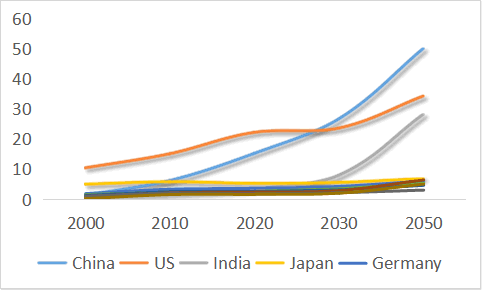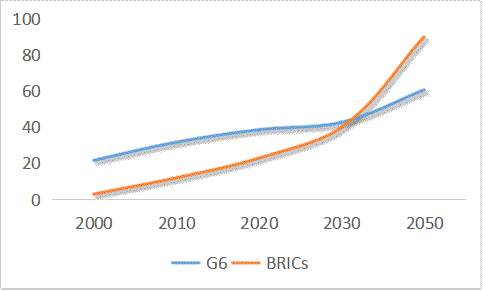The Great Shift of Global Economic Power
Economics / Global Economy Sep 06, 2017 - 07:04 AM GMTBy: Dan_Steinbock

 BRIC economies continue to grow. In the late 2020s, the size of China’s economy will surpass that of the US. By the early 2030s, the BRICs’ combined economic power will surpass that of major advanced nations.
BRIC economies continue to grow. In the late 2020s, the size of China’s economy will surpass that of the US. By the early 2030s, the BRICs’ combined economic power will surpass that of major advanced nations.
The BRICS Summit in Xiamen, Fujian province, signals the rising might of the large emerging economies, such as China, India, Russia, and Brazil. South Africa does not fulfill the criteria of a true BRIC economy - large population, strong growth record and catch-up potential - but it has historically played a key role in African governance.
As global economic prospects now look brighter in the major advanced economies, some observers believe their recovery will weaken the role of the BRICS in global economy and governance. But the realities are quite different.
China the largest economy by the late 2020s
The four key BRIC economies are often compared with major advanced economies, or the so-called G6: the United States, Japan and the four core European nations: Germany, UK, France and Italy.
In 2000, China’s economy was barely a tenth of that of the US, whereas Japan’s GDP was still as large as the three largest European economies together: Germany, the UK and France. Brazil was struggling for stability, Russian economy had been crushed by US-led “reforms,” while change was only beginning in India.
By the early 2010s, the world economy looked very different. The US economy was still more than twice as big as that of China but Japan’s growth had been penalized by stagnation. Chancellor Merkel’s Germany and President Sarkozy’s France ruled over Europe. In Brazil, the Lula era brought about a dramatic catch-up. In India, growth had accelerated. In Russia, President Putin’s rule had multiplied the size of the economy by almost six-fold.
If China can stay on course, the size of its economy shall surpass that of the US by the late 2020s. Despite growth deceleration, which is normal after intensive industrialization, China has strong growth potential until the 2030s, whereas US growth is slowing by maturing economy and aging demographics.
Should President Trump succeed in the plan to cut immigration by 50 percent, US productivity and growth would deteriorate significantly more. In Europe, the net effect of anti-immigration sentiment is likely to generate similar adverse damage.
By 2050, Chinese economy could be almost 50 percent bigger than its US counterpart, while the Indian economy may follow in the footprints and surpass America a few years later. Japan and the core EU economies follow far behind (Figure 1).
In early 2030s, emerging economies will override G6
What will the catch-up by the BRIC economies mean in terms of global economic power? In 2000, the major advanced nations, as reflected by the G6, were almost ten times bigger than the the BRICs.
Figure 1 The BRIC and G6 Countries, 2000-2050 (USD trillion)

In the aftermath of the global crisis, their dominance had shrunk dramatically. In 2010, they were only three times as large as the BRICs.
In the coming decade, secular stagnation in the US, Western Europe and Japan will sustain relatively low growth, whereas large emerging economies, despite relative growth deceleration, will continue their historical catch-up.
In barely a decade and half - by the early 2030s - the BRICs collective economic power will surpass that of the G6. And by the mid-21st century, the BRICs could be some 50 percent bigger than their advanced counterparts (Figure 2).
Figure 2 The G6 and BRIC Economies, 2000-2050 (USD trillion)

In these scenarios, I have used publicly-available economic data by the International Monetary Fund (IMF) and projections based on history, industrialization and sustained growth potential.
However, even if something is possible does not mean that it will be actualized. Over time, both advanced and emerging economies must engage in structural reforms to realize their full potential.
Nevertheless, BRIC scenarios may not be optimistic enough because there are still other fairly large emerging economies that are likely to expand fast and significantly by 2050. Indonesia could become the fourth largest economy in the world, while Mexico and Turkey could grow bigger than Germany and France, respectively. Meanwhile, the economies of new rising powers - Saudi Arabia, Nigeria, Egypt, Pakistan, Iran, the Philippines and Vietnam - could each prove bigger than that of Italy.
Overall, large emerging nations are most likely to realize their potential if they can work together and intensify global trade and investment.
Dr Steinbock is the founder of the Difference Group and has served as the research director at the India, China, and America Institute (USA) and a visiting fellow at the Shanghai Institutes for International Studies (China) and the EU Center (Singapore). For more information, see http://www.differencegroup.net/
The original, slightly shorter version was published by South China Morning Post on February 28, 2017
© 2017 Copyright Dan Steinbock - All Rights Reserved
Disclaimer: The above is a matter of opinion provided for general information purposes only and is not intended as investment advice. Information and analysis above are derived from sources and utilising methods believed to be reliable, but we cannot accept responsibility for any losses you may incur as a result of this analysis. Individuals should consult with their personal financial advisors.
© 2005-2022 http://www.MarketOracle.co.uk - The Market Oracle is a FREE Daily Financial Markets Analysis & Forecasting online publication.


